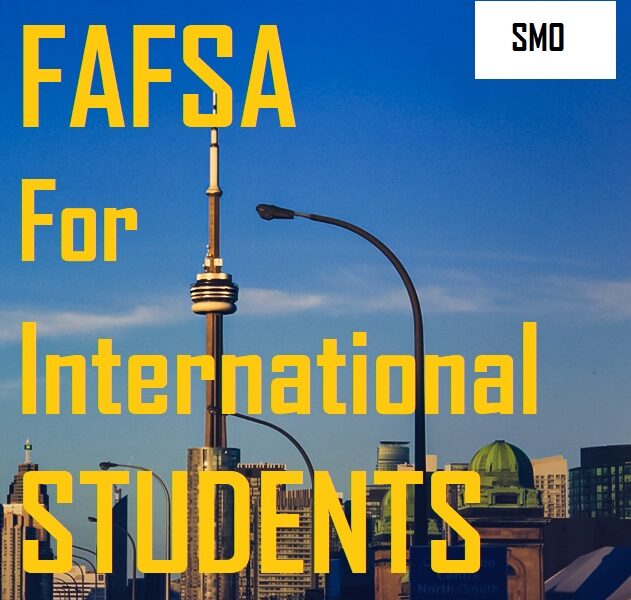Pursuing higher education in the United States as an international student can be an exciting but financially challenging journey. While FAFSA (Free Application for Federal Student Aid) is a crucial funding tool for U.S. citizens, many international students are left wondering: Can I apply for FAFSA?
This comprehensive 2025 guide dives deep into FAFSA, explains who is eligible, highlights alternatives for international students, and offers tips on securing financial aid and scholarships to fund your U.S. education.
What Is FAFSA?
The Free Application for Federal Student Aid (FAFSA) is a government form managed by the U.S. Department of Education. It determines your eligibility for federal financial assistance, including:
- Pell Grants
- Federal student loans (subsidized and unsubsidized)
- Federal Work-Study programs
- State-specific aid (in many states)
FAFSA is completely free to submit and must be renewed every academic year.
Are International Students Eligible for FAFSA?
Generally, international students are NOT eligible for FAFSA.
FAFSA is limited to:
- U.S. citizens
- U.S. nationals
- Green Card holders (Permanent Residents)
- Refugees and asylees
- Individuals with T-Visa or Cuban-Haitian Entrant status
You may be eligible if you fall into these non-citizen categories:
| Status | FAFSA Eligible? |
| Permanent Resident (Green Card) | ✅ Yes |
| Refugee / Asylee | ✅ Yes |
| DACA Recipient (Dreamer) | ❌ No (some state aid possible) |
| F-1 / J-1 / M-1 Visa | ❌ No |
| TPS Holder | ✅ In some cases |
Why FAFSA Still Matters for International Students
Even though you’re likely not eligible for federal aid, some universities use the FAFSA form to assess a student’s overall financial need or compare aid packages. You can also complete the CSS Profile or the International Student Financial Aid Application (ISFAA) instead.
FAFSA Alternatives for International Students
1. CSS Profile
- Managed by College Board
- Accepted by over 400 U.S. colleges
- Assesses institutional aid eligibility (not federal aid)
- Fee: $25 for the first school, $16 for each additional
- Used by top-tier schools like Harvard, Yale, Stanford
2. ISFAA (International Student Financial Aid Application)
- Used by schools that don’t participate in CSS Profile
- Paper-based, simpler than CSS
- Must be submitted directly to each institution
3. Institutional Aid & Scholarships
Many U.S. universities offer their own need-based or merit-based scholarships for international students. Some popular types include:
- Entrance/merit scholarships
- International student tuition waivers
- Graduate assistantships
- Work-study programs on campus
Top Scholarships for International Students in the U.S.
| Scholarship | Value | Eligibility |
| Fulbright Foreign Student Program | Full tuition + living | Graduate-level, any field |
| Hubert Humphrey Fellowship | Full | Mid-career professionals |
| AAUW International Fellowships | $18,000–$30,000 | Women scholars from abroad |
| Clark University Global Scholars Program | $15,000–$25,000/year | Undergraduate applicants |
| ICSP Scholarship (University of Oregon) | Tuition waiver | Public service required |
Apply early! Deadlines are usually 6–12 months before your intended start date.
Can International Students Work to Fund Education?
Yes, but with restrictions:
F-1 Student Visa Work Rules:
| Work Type | Permitted? | Notes |
| On-campus (20 hrs/week) | ✅ Yes | During school sessions |
| Off-campus (CPT/OPT) | ✅ Yes | Must be approved |
| Unauthorized Work | ❌ No | Violates visa status |
Always consult your Designated School Official (DSO) before accepting any job offer.
Financial Aid from Your Home Country
Some governments offer sponsorship or low-interest loans to students studying abroad. Examples include:
- Nigeria: TETFund, PTDF scholarships
- India: JN Tata Endowment, ICCR
- China: CSC Scholarships
- Saudi Arabia: King Abdullah Scholarship
- Brazil: Science Without Borders
Check your country’s Ministry of Education or Embassy in the U.S. for opportunities.
FAFSA-Like Documents You Can Submit
While you can’t use FAFSA for federal aid, some colleges may accept these as proof of financial standing:
- Tax returns (from your home country)
- Bank statements
- Affidavit of support (if sponsored)
- CSS Profile or ISFAA forms
- Statement of need or purpose
U.S. Colleges Known for Generous Aid to International Students
| University | Type of Aid | Coverage |
| Harvard University | Need-based | Full (based on income) |
| Yale University | Need-based + Merit | Up to 100% |
| Berea College | 100% Tuition Waiver | All accepted students |
| Amherst College | Need-based | Up to full ride |
| New York University (NYU) | Limited | Based on academic performance |
How to Apply for Aid as an International Student
Step 1: Research FAFSA-Alternative Schools
Make a list of universities that offer institutional aid to non-U.S. citizens.
Step 2: Prepare Financial Documentation
Gather tax returns, pay slips, bank balances, sponsorship letters, etc.
Step 3: Submit CSS Profile or ISFAA
Each school has its own preferred system—read instructions carefully.
Step 4: Apply for Admission + Scholarships
Follow each institution’s deadlines closely. Some require separate scholarship applications.
Step 5: Interview or Essay (If Required)
Be prepared to explain your financial situation and academic goals.
Bonus: Tips to Maximize Financial Aid
- Apply early – many scholarships are first-come, first-served
- Apply to multiple schools – compare aid packages
- Highlight leadership or volunteer work in your application
- Seek out organizations in your home country offering external aid
- Look into tuition installment plans
Avoid These Common Mistakes
- Don’t apply for FAFSA unless eligible
- Don’t assume aid will be automatic—submit forms
- Don’t forget about exchange rate fluctuations when budgeting
- Don’t ignore hidden fees (insurance, lab fees, housing)
FAQs – FAFSA for International Students
Q1: Can international students fill out the FAFSA form?
You can technically fill it out, but unless you’re an eligible non-citizen, it won’t result in federal aid.
Q2: Do international students get any aid?
Yes, through:
- CSS Profile
- ISFAA
- Private & institutional scholarships
- Work-study (on-campus only)
Q3: Does FAFSA check international bank accounts?
No. FAFSA is not typically relevant for international-only accounts unless you are a U.S. resident or green card holder.
Q4: Can I get a student loan as an international student?
Yes. Options include:
- Private loans with a U.S. cosigner (e.g., Sallie Mae, MPower)
- Home country government education loans
- University-backed emergency loans
Financial Aid Is Possible Without FAFSA
While FAFSA isn’t accessible for most international students, there are still plenty of pathways to fund your U.S. education—through scholarships, institutional aid, private loans, and work-study programs.
By being proactive, organized, and informed, you can reduce your out-of-pocket costs and turn your dream of studying in the United States into a reality.
Ready to start your journey? Begin exploring international-friendly schools and their financial aid options today!










